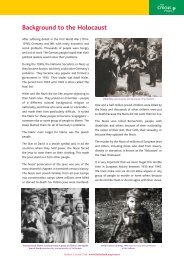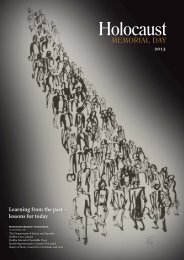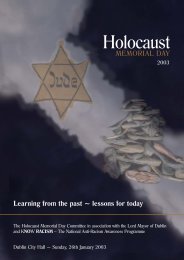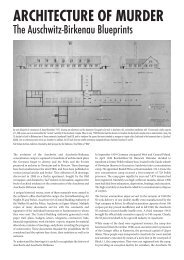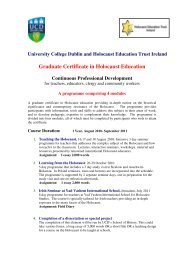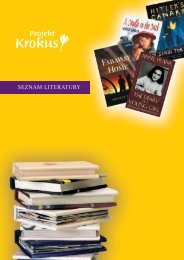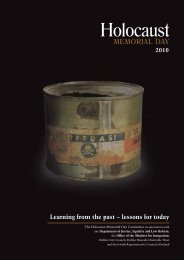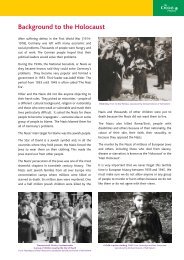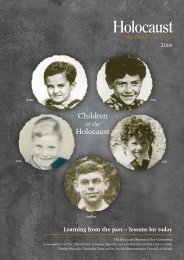Learning from the past ~ lessons for today - Holocaust Education ...
Learning from the past ~ lessons for today - Holocaust Education ...
Learning from the past ~ lessons for today - Holocaust Education ...
You also want an ePaper? Increase the reach of your titles
YUMPU automatically turns print PDFs into web optimized ePapers that Google loves.
<strong>Holocaust</strong> Memorial Day 2007<br />
Inge’s Story<br />
In 1942 my widowed mo<strong>the</strong>r<br />
and five bro<strong>the</strong>rs, Sigmund,<br />
Kurt, Walter, Herbert and Fritz,<br />
were deported <strong>from</strong> Vienna to<br />
Minsk in <strong>the</strong> <strong>for</strong>mer USSR.<br />
From evidence given in <strong>the</strong><br />
post-war Criminal Trials we<br />
know what <strong>the</strong>y, with<br />
thousands of o<strong>the</strong>r Austrian<br />
Jews, endured be<strong>for</strong>e <strong>the</strong>y<br />
were finally shot or gassed. I<br />
am grateful <strong>for</strong> this<br />
opportunity to remember<br />
publicly and in print, <strong>the</strong>ir<br />
Passport issued to Inge Frankel<br />
(Rad<strong>for</strong>d) with ‘J’ <strong>for</strong> Jew clearly suffering when <strong>the</strong>y were<br />
stamped on it in red. initially incarcerated in <strong>the</strong><br />
Minsk ghetto and <strong>the</strong>n transferred to <strong>the</strong> labour/death camp<br />
in <strong>the</strong> village of Maly Trostinec.<br />
That we five grew into relatively unscarred and useful citizens<br />
was due to many people – Jewish and non-Jewish – whose<br />
aim, whe<strong>the</strong>r acting <strong>from</strong> religious or humanitarian motives,<br />
was to minimise <strong>the</strong> trauma of family separation and loss <strong>for</strong><br />
us and <strong>for</strong> hundreds of o<strong>the</strong>r Refugee Children. People such<br />
as <strong>the</strong> Danish branch of <strong>the</strong> Women’s International League <strong>for</strong><br />
Peace and Freedom arranged <strong>for</strong> 25 Viennese boys to be<br />
looked after and trained by Danish farming families. Regional<br />
Committees were also set up all over <strong>the</strong> UK to raise money<br />
and find accommodation <strong>for</strong> o<strong>the</strong>rs. My sister lived happily<br />
with a Yorkshire Baptist family until she joined our older sister<br />
in America. Again a local Voluntary Committee set up in<br />
Sevenoaks, Kent – <strong>the</strong> epitome of ‘middle England’ – raised<br />
money to bring me and five o<strong>the</strong>r children out of Europe, and<br />
to guarantee <strong>the</strong> £50 per child asked <strong>for</strong> by <strong>the</strong> British<br />
Government who had arranged <strong>the</strong> mechanics of our escape.<br />
This camp was built by Soviet prisoners-of-war and Jewish<br />
slave labour. Conditions <strong>for</strong> <strong>the</strong> prisoners were extremely<br />
harsh and <strong>the</strong>ir treatment was brutal. They were housed in<br />
damp barracks and slept on straw in three-tiered bunks made<br />
<strong>from</strong> thick, unshaved planks with no bedding or mattresses.<br />
The camp staff were free to beat, shoot or hang any prisoner<br />
on <strong>the</strong>ir own authority alone. A subterranean bunker was<br />
built with a Nazi tank standing above it. Those who were to be<br />
killed next day were held in <strong>the</strong> bunker.<br />
Murder at Maly Trostinec was committed mainly by shooting<br />
prisoners in <strong>the</strong> <strong>for</strong>ests surrounding <strong>the</strong> village. Be<strong>for</strong>e <strong>the</strong>y<br />
were killed, <strong>the</strong> victims had to undress and hand over <strong>the</strong>ir<br />
possessions, <strong>the</strong>n march in <strong>the</strong>ir underwear to <strong>the</strong> 60m long<br />
and 3m deep pits where <strong>the</strong>y were shot by <strong>the</strong> SS. To cover <strong>the</strong><br />
shots and <strong>the</strong> screams, music was played <strong>from</strong> a gramophone,<br />
amplified by a loudspeaker.<br />
Maly Trosinec had no permanent gas chambers but a fur<strong>the</strong>r<br />
contribution to <strong>the</strong> Nazi’s “Final Solution <strong>for</strong> <strong>the</strong> Jewish<br />
Problem” was made by <strong>the</strong> use of mobile gas vans. In May<br />
1943, 500 victims were murdered every day in <strong>the</strong> gas vans<br />
which went daily to and <strong>from</strong> Minsk and Maly Trostinec.<br />
Five of my family were spared <strong>the</strong> unspeakable ordeal of<br />
ghetto living, imprisonment and violent death. At 16 my<br />
eldest sister, Elli, went to live with relatives in <strong>the</strong> USA. My 13<br />
and 14 year old bro<strong>the</strong>rs, Ernst and Erich, went to live on farms<br />
in Denmark, and my 9 year old sister, Rose, and I aged 7, came<br />
to England (separately and unbeknown to each o<strong>the</strong>r <strong>for</strong><br />
several years) under <strong>the</strong> auspices of <strong>the</strong> Jewish Children’s<br />
Refugee Organisation.<br />
Inside of passport issued to Inge Frankel (Rad<strong>for</strong>d)<br />
issued by <strong>the</strong> Reich, Vienna 1939.<br />
Homes and hearts were opened to us. Many children, like<br />
myself, stayed with our ‘adopting’ family through school,<br />
university, marriage and parenthood. For me, <strong>the</strong>se new, kind<br />
and loving relationships blurred <strong>the</strong> picture of a small, smiling<br />
woman surrounded by several boys all waving as <strong>the</strong> train<br />
pulled out of Vienna station. Even so, during sleep <strong>the</strong>re have<br />
always been chinks in <strong>the</strong> protective layer of acquiescence and<br />
acceptance that mask <strong>the</strong> bewilderment and hurt which are<br />
allowed to surface only in dreams. High-roofed buildings like<br />
Victorian railway stations, journeys, chase and escape,<br />
frightening darkness and reassuring light are recurring<br />
symbols. A red ball, smoked cheese sandwiches, and a little<br />
brown cardboard case accompanied me on <strong>the</strong> journey across<br />
Europe. Small wonder that in waking life I still treasure (and<br />
share with anyone in <strong>the</strong> family undertaking a potentially<br />
difficult journey), <strong>the</strong> Miraculous Medal of <strong>the</strong> Virgin given to<br />
me by <strong>the</strong> nuns who looked after me.<br />
Inge Rad<strong>for</strong>d, Ireland<br />
23






